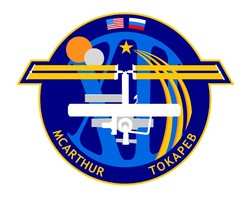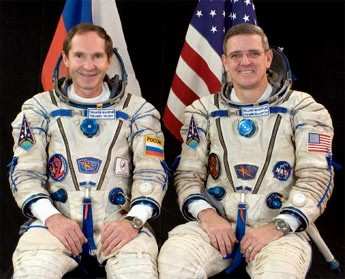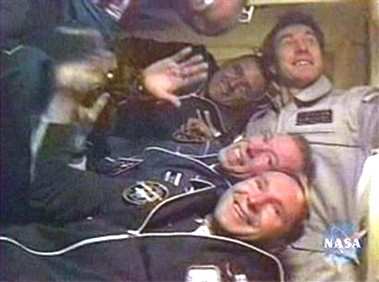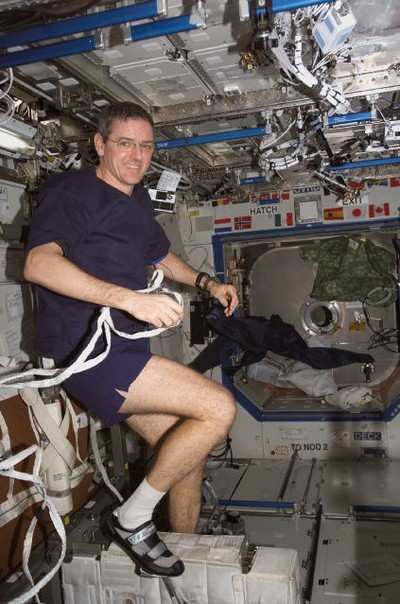2006 Report #13, 4 p.m. CST, Friday, March 24, 2006
 The Expedition 12 crew members have
the International Space Station poised and ready for their
replacements to arrive March 31.
The Expedition 12 crew members have
the International Space Station poised and ready for their
replacements to arrive March 31.
Soyuz Commander Valery Tokarev and Expedition 12 Commander Bill
McArthur moved their Soyuz spacecraft from the Zarya module to the
Zvezda living quarters module early Monday. They will use the same
vehicle to return to Earth April 8. This week's move opened up the
Zarya docking port for the arrival of the Expedition 13 crew.
The Expedition 13 crew, Commander Pavel Vinogradov and Flight
Engineer Jeff Williams, are in Baikonur, Kazakhstan, awaiting
launch. They are scheduled to lift off at 8:30 p.m. CST March 29.
Coverage of the launch will be broadcast live on NASA Television
beginning at 7:45 p.m. CST.
Managers reviewed preparations for the mission and approved
moving forward with launch at the Soyuz Flight Readiness Review on
Thursday. Although no spacewalk is planned from the station until
July, managers also reviewed issues with spacewalking capability.
They approved a temporary solution to allow a spacewalk if
needed.

The concern with U.S. spacewalks surfaced when engineers found
blisters on handrail bars during production work on the ground. The
finding led to an ongoing evaluation to ensure the handrails'
strength is sufficient. The evaluation is expected to be completed
by the end of April. Meanwhile, the approved procedure for
spacewalks, if one were to be needed, involves attaching crew
safety tethers at the base of the handrails rather than on the bar
of the rails.
Tokarev and McArthur also are continuing to look for Russian
lithium hydroxide canisters on the station. The canisters are used
to scrub carbon dioxide from Russian Orlan spacesuits and would be
used if a spacewalk required using those suits. Regardless of the
outcome of their search, a new supply of canisters will be carried
to the station on a Progress cargo vehicle in April, and the next
spacewalk planned using Russian spacesuits is set for August.

Vinogradov and Williams are planned to dock to the station at
10:19 p.m. CST March 31. They will be joined by Brazil's first
astronaut, Marcos Pontes, for launch. Pontes will spend eight days
on the station under a commercial agreement with the Russian
Federal Space Agency and return home with McArthur and Tokarev.
After a day of light duty and rest Tuesday, McArthur and Tokarev
resumed normal operations, focusing on packing and preparing for
the trip home. They packed personal items as well as hardware and
science supplies that will return with them.
They also continued several science experiments that study
plants in weightlessness and crystal growth in space. The studies
included work with the Russian Matroshka and PLANT experiments and
two Japan Aerospace Exploration Agency experiments, the Granada
Crystallization Facility and the Photon Crystals Growth Facility.
McArthur disassembled and stowed components from the U.S.
Foot/Ground Reaction Forces During Spaceflight experiment. The crew
recently completed that study which investigated the effects of
weightlessness on the legs and feet.

McArthur took time to talk with students during two amateur
radio sessions, one with the Sir James Lougheed Elementary School
in Calgary, Alberta, Canada and a second with more than a thousand
students in Rutigliano, Italy. McArthur has conducted 34 such
sessions with students during his six months in orbit, more than
any other station crew member.
 ANN's Daily Aero-Term (04.26.24): DETRESFA (Distress Phrase)
ANN's Daily Aero-Term (04.26.24): DETRESFA (Distress Phrase) ANN's Daily Aero-Linx (04.26.24)
ANN's Daily Aero-Linx (04.26.24) Airborne 04.22.24: Rotor X Worsens, Airport Fees 4 FNB?, USMC Drone Pilot
Airborne 04.22.24: Rotor X Worsens, Airport Fees 4 FNB?, USMC Drone Pilot Airborne 04.24.24: INTEGRAL E, Elixir USA, M700 RVSM
Airborne 04.24.24: INTEGRAL E, Elixir USA, M700 RVSM Airborne-NextGen 04.23.24: UAVOS UVH 170, magni650 Engine, World eVTOL Directory
Airborne-NextGen 04.23.24: UAVOS UVH 170, magni650 Engine, World eVTOL Directory






